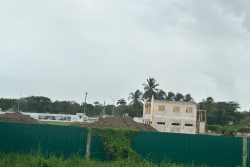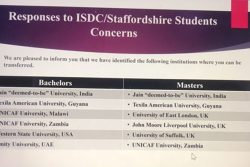-revenue down by 8.6%
The sugar corporation registered a loss of $4.1B for last year – the highest in the past decade – in what GuySuCo said was a challenging year during which rainfall was the highest in 53 years.

GuySuCo’s 2008 report was tabled in Parliament yesterday and the figures showed a reversal in profitability of $4.7B as the corporation had registered a profit of $630M in 2007. It also reflects the phased cutting by 36% of the price offered by the preferential European market for Guyana’s sugar.
In his overview, former Chief Executive Nick Jackson said the very high level of rainfall affected worker turnout, damaged the crop and affected completion of field programmes.
Production for 2008 was 226,268 tonnes compared to 266,482 tonnes in 2007. This was also the lowest output in the last decade. The highest in the last decade was 331,052 tonnes in 2002. The figure was also below the 246,071 in 2005 – the year of the Great Flood. Molasses production was also down – 99,280 tonnes compared to 115, 048 tonnes in 2007.
Jackson said that the scale of the loss was attributable to the low production coupled with big increases in the prices of materials and services.
Revenues were also down by 8.6% from $33.2B in 2007 to $30.3B in 2008. Employment costs – a major expense – was $15.26B, slightly up from $15.21B in 2007.
Referring to the high rainfall, Jackson said that the corporation is “developing strategies to cope effectively with the potentially negative impacts of climate change”. The mean annual rainfall of 2988 mm was 50% above the historical mean of 1998 mm.
Nevertheless, Jackson pointed out that GuySuCo met its major export market obligations and the construction of the new Skeldon factory was completed.
The weather also had a severe impact on field performance. Jackson said that 7,016 hectares of cane were replanted – 63% of the original target.
The same was the case with land preparation which was 7,173 hectares – 63% of the budgeted figure. The industry average cane yield for last year was 57.71 tonnes. “This low performance is a cause for serious concern and a signal that major rehabilitation work will have to be done in 2009”, Jackson added.
He noted that the programme of broad bed conversion to machine friendly layouts is progressing and the East Demerara Estate had completed 2,200 hectares at the point of reporting. He said that the land development programme at Skeldon for private cane farmers and new estate lands had been hamstrung by bad weather for two successive years.
Jackson, who has since taken up a position in Swaziland, pointed out that because of poor cane supply the corporation’s factories were underutilized in 2008. The average weekly grinding hours for all of the corporation’s factories was 97 hours as compared to the budgeted figure of 130.
Skeldon factory
Jackson adverted to the completion of the Skeldon factory during the first quarter of 2008 and the starting of testing in May. The completion of the factory had been delayed. Early first crop tests were inconclusive and full tests started in August at the beginning of the second crop. It had been expected that the new Skeldon factory would have been in place for the grinding of the second crop last year and the first crop this year.
It was noted by the Chief Executive that from August to December there were two lengthy sequences which comprised the contractual Tests on Completion.
“Neither of these was deemed successful although much progress was made and the plant was brought to a condition whereby success should be achieved” at the following tests. The factory is now in operation.
On the financial front, the report said that GuySuCo was badly hit by low production, the prices of key inputs such as fuel and fertilizers and there was also a steep increase in freight costs to Europe. Despite the cash flow difficulties, the contribution to the Skeldon modernisation project was $839M and a further $1.7B was expended on routine capital programmes. Working capital of $2.2B was obtained from the ING bank. This was the fourth year that ING had contributed short-term financing for the corporation. In addition, a consortium of local financial institutions supplied $3.2B in working capital which was employed to fund the end-of-year deficit. The ING financing was repaid as agreed at December 31st.
Marketing
Noting the end of the longstanding Sugar Protocol (SP) with Europe in September and the start of the Duty Free, Quota Free (DFQF) regime, Jackson said that the corporation made its best efforts to supply optimal volumes of sugar ahead of the September deadline. To make up for the production shortfall, sugar was recently imported from Guatemala so that local sugar could be shipped to Europe.
Jackson said that by June 2008 GuySuCo had fully delivered its 2007/8 SP quota of 179,000 tonnes with a three-month extension for the delivery of shortfalls and the Complementary Quantity (CQ) from the second crop. However, the late start to that crop due to the inclement weather and industrial unrest caused a shortfall of 25,000 tonnes in timely shipping. “The quotas have, however, not been lost and will be delivered in the remaining period of the Sugar Protocol”, Jackson added. Guyana was also assigned a further 21,165 tonnes from the shortfalls from Trinidad and Barbados. The final CQ allocation for Guyana was 31,770.
The production shortfall also significantly affected sales to two other key markets: the US and the Caribbean. Whereas 22,400 tonnes had been exported to the US in 2006 and 12,500 tonnes in 2007, GuySuCo supplied only 188 tonnes last year. In 2006, 32,022 tonnes of bagged sugar was supplied to Caricom while in 2008 only 14,421 tonnes of bagged sugar went. There was an increase in packaged sugar sales from 2,979 tonnes in 2007 to 4,126 tonnes last year. In 2008 waivers of the Common External Tariff to several Caricom countries had to be granted after the Guyana shortfall and by the end of last year, a decision was taken to halt sales of bagged sugar to most of the remaining Caricom countries in 2009.
In terms of brand protection, Jackson said that GuySuCo moved closer to having the name Demerara protected internationally.
Occupational health and safety performance improved across most indicators. The Lost Time Accidents per 100,000 worked man-hours was 4.87. This was the best performance since 1994.
There was a measurable increase in the number of vehicular accidents and costs from the damage caused. Vehicle damage increased by 54% and the cost to $6.7M – a 110% rise.








